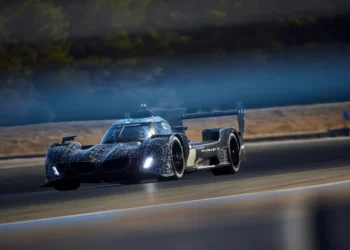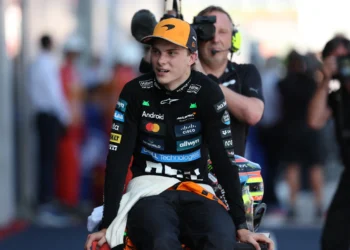Cadillac’s 2026 Formula 1 entry is gaining momentum, and the American powerhouse is reportedly in talks with Ferrari for a suspension supply deal—a move that could streamline its debut and boost its competitive chances from Day 1.
With just over a year before its Grand Prix debut, Cadillac faces an immense challenge to get two race-ready cars on the grid. While the team has secured a Ferrari engine and gearbox deal, filling the void left by Sauber’s transition to Audi, the latest reports suggest Cadillac could deepen its Ferrari ties by adopting the Italian marque’s suspension system as well.
But is this a strategic masterstroke or a shortcut that could limit Cadillac’s long-term potential?
Ferrari Suspension: A Smart Shortcut or a Risky Reliance?
Partnering with an established team for non-listed parts isn’t unusual in Formula 1. In fact, Haas has been running a similar Ferrari-dependent model since its 2016 debut, allowing it to focus on aerodynamics rather than reinventing the wheel.
Other teams have followed suit:
- Racing Bulls (formerly AlphaTauri) uses Red Bull’s suspension and powertrain.
- Aston Martin has historically sourced its rear-end from Mercedes, though that deal ends this year as Aston transitions to its Honda works partnership.
For Cadillac, teaming up with Ferrari for suspension components makes sense:
✅ Speeds up development—One less critical element to design from scratch.
✅ Proven reliability—Ferrari’s suspension is already F1-tested.
✅ More resources for aerodynamics—Cadillac can focus entirely on aero performance, using Toyota’s Cologne wind tunnel to develop its first F1 chassis.
However, there’s a potential downside: If Cadillac leans too heavily on Ferrari’s technology, it risks becoming a “B-team” rather than an independent contender.
Cadillac’s Hidden Advantage: A 2026-Only Focus
Unlike Haas, Williams, and Racing Bulls, who must split their resources between developing their 2025 cars and preparing for the radical 2026 regulations, Cadillac has one singular mission: 2026.
Thanks to F1’s Aerodynamic Testing Restrictions (ATR) rules, Cadillac will benefit from 115% wind tunnel and CFD testing—giving it more development time than any current team.
This means while others juggle short-term and long-term goals, Cadillac can pour everything into its first car.
Yet, not everyone in the paddock believes Cadillac has a true head start.
Rival Teams Dismiss Cadillac’s “Advantage”
While Williams, Aston Martin, and Racing Bulls acknowledge Cadillac has more time to focus on 2026, they argue that strict FIA regulations will prevent any unfair advantage.
Williams boss James Vowles:
“They should fall under FIA ATR and cost cap regulations in 2025.
Is there a head start? Maybe. But I think it’s controlled fairly well under some FIA regulations.”
Aston Martin’s Mike Krack:
“It’s a monumental task to set up a team for 2026, especially with new regulations.
Even if there was a small head start, it will balance out very quickly.”
Racing Bulls’ Laurent Mekies:
“By the time January 1st [2025] turns up, everything will be well controlled by the regulations.”
Their message? Cadillac may have time, but time alone doesn’t guarantee success.
The Road Ahead: Can Cadillac Be Competitive from Day 1?
Cadillac’s Ferrari partnership and unrestricted 2024 development give it a fighting chance to be competitive when it hits the grid in March 2026. But Formula 1 is ruthless—and no team, no matter how well-prepared, can expect instant success.
If Cadillac nails its first design, its all-in approach could propel it beyond the typical struggles of an expansion team. But if it fails to develop a competitive car, it could find itself at the back of the grid, struggling to justify its place in F1.
Either way, one thing is certain: Cadillac’s journey to Formula 1 will be one of the biggest stories to watch in 2026.













